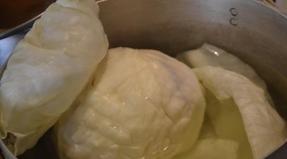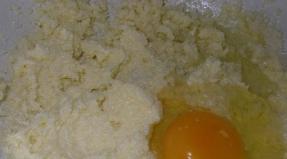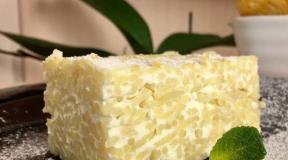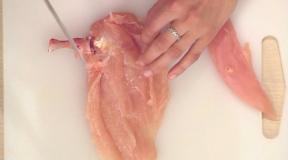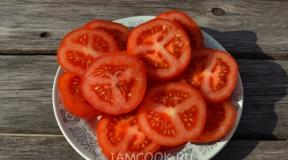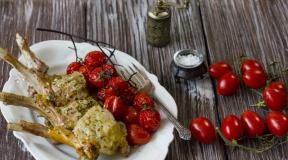The Japanese eat live snakes. Unusual Japanese cuisine: not for the faint of heart! Eel fry, Japan
Impressed by such an unusual "live" dish, we studied Japanese cuisine a little, and found in it a lot more shocking and at the same time interesting. Unusual for many, the world of Japanese cuisine has a long history, counted for centuries, its own unique traditions and unshakable customs. Perhaps it is Japanese cuisine that is an example of originality, diversity and usefulness, which is why it appealed to people living in different parts of the Earth.
The comment about this video caused a storm of emotions
- At the same time, the materials of this post may be unacceptable for many "non-Japanese". Please go to another page if you are very sensitive to the issues of vegetarianism.
1. Squid dances "Odori Donu"
Only fresh squids are used to prepare Odori Donu, as they are butchered, leaving only the tentacles intact. In order for the squid to “start dancing”, you need to pour soy sauce on them. Due to the fact that the sodium ions contained in soy sauce react with the still living squid cells, the impulses cause the squid muscles to contract.
2. Dish of raw horse meat "Basashi"
The Japanese poetically call horse meat sakura. They say that this dish tastes very good, like "sushi"!
By the way, meat was sometimes eaten in Japan in the past, but it never became part of the traditional cuisine, which was built entirely from vegetables, fish and seafood. Until our time, beef, pork and even chicken did not occupy a significant place in the diet of the Japanese. Although the Japanese in the mountain villages ate the meat of wild boars, deer, other animals and birds, in the whole country the meat was considered a special food, for example, for the sick. One of the reasons for the absence of meat in Japanese cuisine is the adoption of Buddhism, which forbade the eating of four-legged animals, although the Japanese have never been fundamentalists in religion. But people who cut meat were considered unclean. A more important reason, perhaps, is the lack of space - scarce and precious arable land has been completely given over to rice fields. In Japan, there was simply no place for raising livestock, and the Japanese obtained the necessary proteins from seafood and soy.
3. Natto
This is Natto. Natto refers to traditional Japanese cuisine, made from fermented soybeans, usually eaten with soy sauce.
This dish has a strong smell, but it is delicious. Tourists say: “If you have never eaten it, you should definitely try it!!!”
4. Inago no tsukudani
In rural localities in Nagano and Gunma, one can find a dish called "Inago no tsukudani". Inago is a type of grasshopper that is stewed in soy sauce with added sugar. In many souvenir shops you can find this delicacy packaged to take home or to your family and friends as a souvenir.
5. Shirako
What do you think this product is? And this is one of the oddities of Japanese cuisine, because Shirako is fish sperm! It can be steamed or deep fried, but no amount of processing will take away the awkward silence when you tell your friends you ate it ;)
6. Ikizukuri (live sashimi)
In general, Sashimi (sashimi) is a traditional Japanese dish that is prepared from fresh raw fish. Usually sashimi is served as the first course and symbolizes the beginning of the meal. In Japan, this dish is prepared not to satisfy hunger, but, first of all, to demonstrate the culinary skills of the chef. Very often, various compositions in the form of flowers and hieroglyphs are formed from thin slices of fish.
Ikizukuri is the practice of making sashimi with more than just live seafood… When the fish is chosen, the chef starts gutting it and serving it almost immediately. The aerobatics in this case is that the chef carefully cuts off a few pieces, however, the fish itself at the same time remains relatively untouched.
Moreover, everything is cut off so that a person, eating pieces of sashimi, sees how the heart of the fish works, and how it moves its mouth while he eats.
On the one hand, this may seem like a kind of provocation or an attempt to force people to become vegetarians.
Live sashimi in serving
7. Odori Ebi
Odori Ebi is also a type of sashimi, which consists of small baby shrimp. Their shells are often removed, and sometimes their heads. The shrimp is fried and served along with the remaining parts of the body, which continue to be moved while eating with paws and antennae.
Odori Ebi Live In Submission
- Shrimp can be immersed in an alcoholic drink, it will get drunk and easier to eat. She only dies when they start chewing her. This dish will cost you quite a lot in a restaurant, because in order for the shrimp to remain alive, it must be cooked very quickly and skillfully, and far from any cook can do this.
Exotic dishes, which are considered delicacies in different countries, are sometimes completely different from what we are used to seeing on our dinner table. Although some dishes of Russian cuisine may also seem strange to residents of other countries - for example, Europeans are very surprised by dishes such as pickled cucumbers, jelly, or, say, jelly, but be that as it may, our culinary traditions are much more humane in relation to eaters and ... dishes. Why - you will learn from this collection.
1 Octopus
© JEJUNG YEON-JE / AFP / Getty ImagesIn Korea, this delicacy is called sannakji. The dish is a live octopus seasoned with sesame seeds and sesame oil. Immediately before serving, the animal is cut into small pieces, and then the still writhing tentacles are eaten.
The muscles of the cooked octopus retain the ability to contract for some time, therefore, when eating the dish, special attention should be paid to ensure that, in its death throes, the animal does not catch on the tongue or oral cavity with its suckers and does not block the human respiratory tract. There have been cases when gourmets died from suffocation while carelessly eating live octopuses.
2. Frogs
Eating live octopuses is not the only Asian food tradition that can seem disgusting. In China, Japan and Vietnam, a dish is quite popular, the main ingredient of which is a live frog. You can admire how the Japanese masterfully cracks down on this gourmet dish, but it's better not to watch the video during your lunch break - you risk spoiling your appetite.
Most often, the “delicacy” is prepared from specially grown frogs, the process of its preparation is not complicated - the frog is skinned, gutted, then cut into pieces and laid out on a plate with a side dish, the main decoration of the delicacy is a still living frog head. Sometimes a beating heart is served separately as a "highlight".
3. Tarantulas
Sophisticated gourmets can hardly be surprised by delicacies, say, from deer testicles or a bull penis, however, the gastronomic addictions of the British Louis Cole will shock even experienced gluttons.
Cole regularly records videos of him eating various "foods", including live tarantulas and scorpions. The Briton has already shot 36 videos, one more disgusting than the other, you can see them on his official channel in the youtube.com service. However, you'd better not see it.
4. Fruit bats

Again Asia and again - culinary delights, the preparation and eating of which can be equated with cruelty to animals.
Representatives of the winged family are one of the most popular delicacies in Asian cuisine. Fruit bats, which are also called flying dogs (not to be confused with bats!), are eaten in Indonesia, Singapore, Thailand, Vietnam and other countries of the Asia-Pacific region, and the cooking methods are very different - they are stewed, boiled soups, deep-fried and cooked Grilled. Those who have tasted flying dogs claim that their meat is similar to chicken - there is practically no fat in it, but there is a lot of protein and it is easily digested.
I must say that in almost all Asian countries fruit bats are killed before cooking, but there is an exception: one of the dishes of the national cuisine of the island of Guam is live fruit bats in coconut milk. Animals are caught, washed (and thanks for that), and then whole, together with wool and wings, are immersed in vats of boiling water, making sure that the fruit bat is alive when it is served. The finished dish is seasoned with coconut milk, vegetables are used as a side dish.
If you are ever “lucky enough” to cook this dish yourself, keep in mind that fruit bats emit a specific smell of urine and feces - flying dogs spend most of their lives upside down, so there is always a certain amount of feces on their body. To get rid of the “wonderful” aroma, fruit bats should be washed thoroughly, and during cooking, you can add garlic, onions, chili peppers or ... beer to the water.
5. Snakes
 Eating live snakes is still exotic even for India. Farmer Sutari Nayak, a resident of the Indian state of Orissa, is considered the main specialist in "snake cuisine". In 2007, the farmer, then 46 years old, became famous for eating live snakes - in his own words, "just for fun." The man confesses that he started eating reptiles as a child, after his friend was bitten by a poisonous snake: "If snakes bite us, why can't we bite a snake?"
Eating live snakes is still exotic even for India. Farmer Sutari Nayak, a resident of the Indian state of Orissa, is considered the main specialist in "snake cuisine". In 2007, the farmer, then 46 years old, became famous for eating live snakes - in his own words, "just for fun." The man confesses that he started eating reptiles as a child, after his friend was bitten by a poisonous snake: "If snakes bite us, why can't we bite a snake?"
Nyak eats snakes alive, without any heat treatment. For several years now, the farmer has been considered a local "star" and even manages to earn money thanks to his gastronomic addictions.
6. Larvae

Casu marzu is one of the most unusual delicacies that you can enjoy in Italy, it is considered a specialty of the island of Sardinia and is popular among tourists and locals alike. The food is nothing more than cheese made from sheep's milk, in which live insect larvae swarm. The larvae contribute to the rapid breakdown of the fats contained in the cheese, making the product remarkable for its amazing tenderness and softness. In the process of decomposition of fats, a liquid is released from the cheese, which is called lagrima (in the lane with Sard. - “tears”). Before eating, you can clean the cheese from a specific “seasoning”, but true connoisseurs of Sardinian cuisine leave everything as it is, trying to enjoy every larva.
7. Ants
If you are not too squeamish about food and you happen to travel around Denmark, be sure to check out the Noma restaurant in the capital - they serve a delicacy of lettuce leaves seasoned with chilled (to crawl more slowly) ants. The delicacy is not cheap - about $ 300 per serving, the institution positions it as a gluten-free (proteins found in cereals) alternative to toast. Judging by the reviews of restaurant visitors, the taste of ants is similar to ginger, cilantro or lemongrass (a genus of cereal plants).
8. Shrimp

What do the Japanese dish "odori ebi" (translated as "dancing shrimp") have in common with the Chinese delicacy called "drunken shrimp"? In both cases, shrimp are served alive, only in Japan children are used to prepare this type of sashimi - the animals are fried over low heat so that they do not die and eat immediately, dipped in sake, and in China the dish is prepared from adults shrimp and served in a warm "soup" of baijiu - a strong Chinese liquor.
To fully enjoy a Chinese or Japanese delicacy, you will need a fair amount of skill - the animals are quite agile, actively moving their paws and even trying to get out of the plate. Also, it is necessary to chew each shrimp carefully, otherwise they will continue to move in the stomach.
9. Cockroaches

As you know, in the United States, speed eating contests are often held for various dishes, and American eaters are ready to absorb in huge quantities not only Big Macs and hot dogs, but also, say, insects. Such competitions are not only disgusting, but also life-threatening - for example, 32-year-old Edward Archbold, a participant in one of these events, died after eating several dozen worms and a whole bucket of giant cockroaches.
In some ways, Archbold's death can be considered heroic - he hoped to win the competition's top prize, a live python to give to his friend. An autopsy showed that the American died of asphyxiation - his airways were clogged with cockroach legs.
10. Acne

Japanese national cuisine is famous for its originality - in addition to frogs and shrimp (see paragraphs 2 and 8, respectively), the inhabitants of the Land of the Rising Sun eat eels alive. According to Raymond Blanc, the famous chef, while traveling in Japan he had to try this unusual delicacy - to set off the taste, eels are seasoned with vinegar and sake, and then swallowed whole.
 Most people prefer their food to be fresh, but there are some peoples and cultures who take this too literally. Attention impressionable readers and members of Greenpeace: here is a list of animals that are eaten while they are still alive. If you don't like the fact that dinner can run off your plate, read no further!
Most people prefer their food to be fresh, but there are some peoples and cultures who take this too literally. Attention impressionable readers and members of Greenpeace: here is a list of animals that are eaten while they are still alive. If you don't like the fact that dinner can run off your plate, read no further!
Octopus

Sea urchin
These echinoderms may not look very appetizing given their spiky exterior, but they are prized the world over for their roe and slightly fishy flesh. Although they are often eaten raw, such as in sushi - sea urchin roe is commonly called "Uni", some people prefer to eat them alive, right after cutting the shell.

Larvae and insects
If you've ever seen the reality show Fear Factor, then you've probably witnessed live insects being eaten. In many parts of the world, this practice is fairly common. Insects and their larvae offer excellent sources of protein and many who have been brave enough to try them will insist they taste good too! One example is witchetty GRUB, a gem of Australian Aboriginal cuisine, these larvae can be eaten live or boiled.
But Dutch scientists consider insect larvae to be a much cheaper and more environmentally friendly protein food, while not inferior in value to meat and poultry. In their opinion, the food problem should be solved by insects, or rather, their larvae. So, for example, the production of a kilogram of protein from larvae in total (taking into account the area of planting fodder crops, etc.) requires about ten times less territory than the production of a kilogram of beef protein, and several times less than obtaining an equivalent amount of pork or chicken squirrel. At the same time, the breeding of larvae emits much less greenhouse gases than any kind of animal and poultry farming.

oysters
Irish publicist Jonathan Swift is famous for saying "He was a brave man who ate oysters first". But to our Western beliefs, oysters are the most common living things eaten raw and alive. In fact, oysters are considered healthiest when eaten raw, half shelled.
It is very easy to check if it is alive, just squeeze a couple of drops of lemon. The oyster should stir.
Champagne or other light dry wine goes well with this gourmet appetizer (Riesling or Chardonnay are especially good with oysters, Spanish dry sherry is good).

Bon appetit!
Products must be fresh, this is an unshakable rule of a healthy diet. But live foods are another matter altogether. And we are not talking about those animals that are killed before deliveries to shops and restaurants. No. We are talking about animals that are served on a plate alive. Sounds awful. But in many countries, such dishes are considered a delicacy. We offer an overview of the most sadistic dishes in the world.
Adherents of "live dishes" believe that meat is tastier if the animal is alive, partially alive, or breathed its last breath right on the plate of those who were going to eat it. To call such delicacies amazing simply does not turn your tongue. They are not what they are, but it is impossible to look at the photograph without a shudder. The faint of heart and impressionable do not look.

Huge fat grubs can be a tasty meal, at least for Australians. It's no secret that in the desert there is a problem with food, so you don't have to choose much. Aborigines enjoy eating caterpillars as a wonderful source of protein. What’s more, they don’t need to be cooked at all. We just find it, tear off the head and chew until they stop wriggling in the mouth. However. A similar dish can be served even in a restaurant in soup or scrambled eggs. Their eating turns into a real ritual.

In Italy, while walking along the coast, it is customary to collect sea urchins and eat them right there. These are such tennis balls in thorns that do not look appetizing at all. But in fact, they have fleshy and tasty, as they say, gonads (sex glands). Therefore, if you want to try a delicacy, you need to crack a prickly nut and eat everything with appetite while it wriggles.

And now it's time to talk about delicious octopus, but not in the form of a frozen sea cocktail, but about the sannakji dish, which is served in Japan and Korea. This is a live octopus, served cut into pieces or whole. Its tentacles are still wriggling when the plate with the dish is placed on the table. The attraction of sannakji lies in the sensations that people experience when chewing on a poor animal. However, not everything is so simple. The dish is quite dangerous, not in vain in some countries it is prohibited. The tentacles are covered with powerful suction cups that can stick inside the throat and simply suffocate the eater.

Blood clams produce an increased amount of hemoglobin, and when the shell opens, rivers of blood simply cannot be avoided. Most people just boil them for 20 seconds and eat them almost raw. You just need to remember that 14-16% of gourmets have a chance to get hepatitis. Because of this, the dish is banned in China, but in New England it is served with citrus sauce.

Restaurant Noma in Copenhagen thought the ant salad was a great idea. They even set the price accordingly: $ 300 per serving. Ants are served with crème fraîche and are offered as a substitute for croutons as a gluten-free ingredient. They taste like a mixture of ginger, lemongrass and cilantro. And they froze them so that they would not run so fast.

Fruit bats are eaten with pleasure in many Asian countries such as Guam, Singapore, Thailand, Indonesia, Vietnam. They are low in fat, high in protein, and taste like chicken. However, on the small island of Guam, locals serve a very unusual dish: a bat with coconut milk soup. The caught animal is washed, thrown alive into boiling water and served on the table. You need to eat everything except bones and teeth.

In some eastern countries, mainly in Japan, China and Vietnam, for lunch they can bring a live frog, cut into fillets, with a still beating heart. For this delicacy, special bullock frogs are grown. The highly impressionable should not order a dish, since the skin from a living animal will be removed right in front of the visitor.

Probably, in Japan and China, it was decided that it was impossible for a sober animal to come to terms with the idea that it would be eaten alive. Therefore, here they decided to alleviate the fate of the shrimp and give them a drink. They are soaked in either sake or baijiu, a Chinese alcoholic drink, and the shrimp start jumping around the plate and table. We free the live shrimp from the shell and bite into the flesh with our teeth.
Eel fry, Japan

In Japan, eel fry are also eaten in the same way as shrimp. Chef Raymond Blanc suggests adding vinegar and sake to get them jumping too. It remains only to swallow them whole. However, there is another traditional dish in the Land of the Rising Sun, which is called "Tofu hell", "Hell of the loach". To cook it, you need to boil water, put a piece of tofu cheese on the bottom and immediately throw small loaches into the pan. They will swim towards the still cold cheese hoping to escape and burrow into it. It's just that they have no chance of surviving. As a result, the dish looks like Swiss cheese, only the holes in it were made by small fish, and not by fermentation.

Ikizukuri, which translates as "cooked alive," is a type of sashimi that is served as soon as the fish is pulled out of the aquarium. The cook just guts it and puts it on the table. The whole process takes place in front of the client, who can watch the beating heart of the fish and the opening and closing of the mouth.
However, this is not the whole list, people's culinary preferences never cease to amaze.
Exotic dishes, which are considered delicacies in different countries, are sometimes completely different from what we are used to seeing on our dinner table. Although some dishes of Russian cuisine may also seem strange to residents of other countries - for example, Europeans are very surprised by dishes such as pickled cucumbers, jelly, or, say, jelly, but be that as it may, our culinary traditions are much more humane in relation to eaters and ... dishes. Why - you will find out from this collection.
1 Octopus
In Korea, this delicacy is called sannakji. The dish is a live octopus seasoned with sesame seeds and sesame oil. Immediately before serving, the animal is cut into small pieces, and then the still writhing tentacles are eaten.
The muscles of the cooked octopus retain the ability to contract for some time, therefore, when eating the dish, special attention should be paid to ensure that, in its death throes, the animal does not catch on the tongue or oral cavity with its suckers and does not block the human respiratory tract. There have been cases when gourmets died from suffocation while carelessly eating live octopuses.
2. Frogs

Eating live octopuses is not the only Asian food tradition that can seem disgusting. In China, Japan and Vietnam, a dish is quite popular, the main ingredient of which is a live frog. You can admire how the Japanese masterfully cracks down on this gourmet dish, but you should not watch the video during your lunch break - you risk spoiling your appetite.
Most often, the “delicacy” is prepared from specially grown frogs, the process of its preparation is not complicated - the frog is skinned, gutted, then cut into pieces and laid out on a plate with a side dish, the main decoration of the delicacy is a still living frog head. Sometimes a beating heart is served separately as a "highlight".
3. Tarantulas

Sophisticated gourmets can hardly be surprised by delicacies, say, from deer testicles or a bull penis, however, the gastronomic addictions of the British Louis Cole will shock even experienced gluttons.
Cole regularly records videos of him eating various "foods", including live tarantulas and scorpions. The Briton has already shot 36 videos, one more disgusting than the other, you can see them on his official channel in the youtube.com service. However, you'd better not see it.
4. Fruit bats
Again Asia and again - culinary delights, the preparation and eating of which is just right to equate to cruelty to animals.
Members of the bat family are one of the most popular Asian delicacies. Fruit bats, which are also called flying dogs (not to be confused with bats!), are eaten in Indonesia, Singapore, Thailand, Vietnam and other countries of the Asia-Pacific region, and the cooking methods are very different - they are stewed, boiled soups, deep-fried and cooked Grilled. Those who have tasted flying dogs claim that their meat is similar to chicken - there is practically no fat in it, but there is a lot of protein and it is easily digested.
I must say, in almost all Asian countries, fruit bats are killed before cooking, but there is an exception: one of the dishes of the national cuisine of the island of Guam is live fruit bats in coconut milk. Animals are caught, washed (and thanks for that), and then whole, together with wool and wings, are immersed in vats of boiling water, making sure that the fruit bat is alive when it is served. The finished dish is seasoned with coconut milk, vegetables are used as a side dish.
If you are ever “lucky” to cook this dish yourself, keep in mind that fruit bats emit a specific smell of urine and feces - flying dogs spend most of their lives upside down, so there is always a certain amount of feces on their body. To get rid of the “wonderful” aroma, fruit bats should be washed thoroughly, and during cooking, you can add garlic, onions, chili peppers or ... beer to the water.
5. Snakes
Eating live snakes is still exotic even for India. Farmer Sutari Nayak, a resident of the Indian state of Orissa, is considered the main specialist in "snake cuisine". In 2007, the farmer, then 46, became famous for eating live snakes — in his own words, “just for fun.” The man confesses that he started eating reptiles as a child, after his friend was bitten by a poisonous snake: "If snakes bite us, why can't we bite a snake?"
Nyak eats snakes alive, without any heat treatment. For several years now, the farmer has been considered a local "star" and even manages to earn money thanks to his gastronomic addictions.
6. Larvae
Casu marzu is one of the most unusual delicacies that you can enjoy in Italy, it is considered a specialty of the island of Sardinia and is popular among tourists and locals alike. The food is nothing more than cheese made from sheep's milk, in which live insect larvae swarm. The larvae contribute to the rapid breakdown of the fats contained in the cheese, making the product remarkable for its amazing tenderness and softness. In the process of decomposition of fats, a liquid is released from the cheese, which is called lagrima (in the lane with Sard. - “tears”). Before eating, you can clean the cheese from a specific “seasoning”, but true connoisseurs of Sardinian cuisine leave everything as it is, trying to enjoy every larva.
7. Ants
If you are not too squeamish about food and you happen to travel around Denmark, be sure to check out the Noma restaurant in the capital - they serve a delicacy of lettuce leaves seasoned with chilled (to crawl more slowly) ants. The delicacy is not cheap - about $ 300 per serving, the institution positions it as a gluten-free (proteins present in cereals) alternative to toast. Judging by the reviews of restaurant visitors, the taste of ants is similar to ginger, cilantro or lemongrass (a genus of cereal plants).
8. Shrimp
What do the Japanese dish "odori ebi" (translated as "dancing shrimp") have in common with the Chinese delicacy called "drunken shrimp"? In both cases, shrimp are served alive, only in Japan children are used to prepare this type of sashimi - animals are fried over low heat so that they do not die and are eaten immediately, dipped in sake, and in China the dish is prepared from adults shrimp and served in a warm "soup" of baijiu - a strong Chinese spirit.
To fully enjoy a Chinese or Japanese delicacy, you need a fair amount of skill - the animals are quite nimble, actively move their paws and even try to get out of the plate. Also, it is necessary to chew each shrimp carefully, otherwise they will continue to move in the stomach.
9. Cockroaches

As you know, in the United States, speed eating contests are often held for various dishes, and American eaters are ready to absorb in huge quantities not only Big Macs and hot dogs, but also, say, insects. Such competitions are not only disgusting, but also life-threatening - for example, 32-year-old Edward Archbold, a participant in one of such events, died after eating several dozen worms and a whole bucket of giant cockroaches.
In some ways, Archbold's death can be considered heroic - he hoped to win the main prize of the competition - a live python to give to his friend. An autopsy showed that the American died of suffocation - his airways were clogged with the legs of cockroaches.
10. Acne

Japanese national cuisine is famous for its originality - in addition to frogs and shrimp (see paragraphs 2 and 8, respectively), the inhabitants of the Land of the Rising Sun eat eels alive. According to Raymond Blanc, the famous chef, while traveling in Japan he had to try this unusual delicacy - to set off the taste, eels are seasoned with vinegar and sake, and then swallowed whole.
